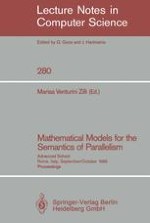1987 | ReviewPaper | Chapter
Designing equivalent semantic models for process creation
Authors : Pierre America, Jaco de Bakker
Published in: Mathematical Models for the Semantics of Parallelism
Publisher: Springer Berlin Heidelberg
Included in: Professional Book Archive
Activate our intelligent search to find suitable subject content or patents.
Select sections of text to find matching patents with Artificial Intelligence. powered by
Select sections of text to find additional relevant content using AI-assisted search. powered by
Operational and denotational semantic models are designed for languages with process creation, and the relationships between the two semantics are investigated. The presentation is organized in four sections dealing with a uniform and static, a uniform and dynamic, a nonuniform and static, and a nonuniform and dynamic language, respectively. Here uniform/nonuniform refers to a language with uninterpreted/interpreted elementary actions, and static/dynamic to the distinction between languages with a fixed/growing number of parallel processes. The contrast between uniform and nonuniform is reflected in the use of linear time versus branching time models., the latter employing a version of Plotkin's resumptions. The operational semantics make use of Hennessy and Plotkin's transition systems. All models are built on metric structures, and involve continuations in an essential way. The languages studied are abstractions of the parallel object-oriented language POOL for which we have designed separate operational and denotational semantics in earlier work. The paper provides a full analysis of the relationship between the two semantics for these abstractions. Technically, a key role is played by a new operator which is able to decide dynamically whether it should act as sequential or parallel composition.
